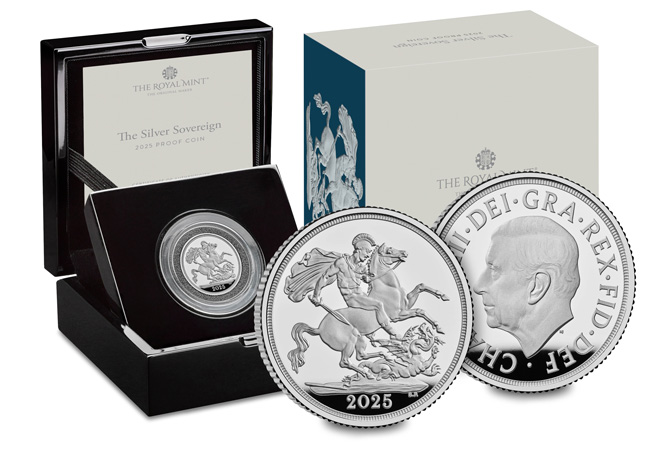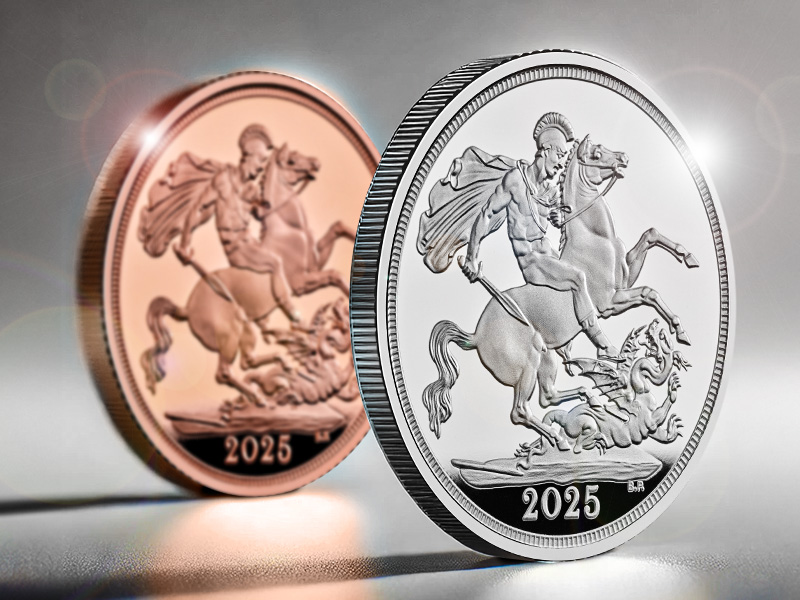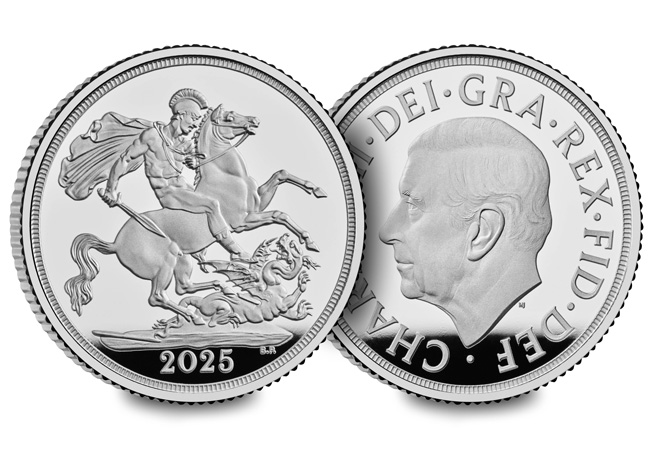Information
A Historic First: The Silver Edition of The Sovereign
For the first time in history, The Sovereign has been struck from pure silver, marking a ground-breaking evolution for this iconic coin. Renowned for centuries as the “chief coin of the world,” The Sovereign’s legacy of impeccable design and quality now takes a dazzling new form. This silver Proof edition isn’t just an historic chapter in numismatic history—it’s a fresh way for collectors to own and celebrate a true British classic. With its radiant silver finish, this reimagined Sovereign is a must-have for any collection, blending tradition with a breath-taking modern twist.

The Important Details
Crafted with the same precision and care as its traditional gold counterpart, this silver Sovereign matches the original in both diameter and weight. Struck to The Royal Mint’s exacting Proof standard, you can truly appreciate the intricacy of the design. It offers a fresh and distinctive way to experience the timeless beauty of The Sovereign.

The reverse of this remarkable piece features Benedetto Pistrucci’s iconic St George and the Dragon design, a classic image that has graced The Sovereign for over 200 years. Pistrucci’s dynamic portrayal of England’s legendary hero has become a defining symbol of this coin, and it’s no less captivating in this silver edition.
A Modern Royal Legacy
On the obverse, the silver Sovereign features the official coinage portrait of His Majesty King Charles III, created by Martin Jennings. This distinguished profile captures the dignity of the new King and marks a new chapter in the coin’s storied history. For collectors, it’s a significant and meaningful way to commemorate this historic period for the British monarchy.

Key Features That Make This Coin Unmissable:
- A Historic First: This is the first time The Royal Mint has released The Sovereign in fine silver.
- Collectible Appeal: A once-in-a-lifetime opportunity to add a brand-new Sovereign variation to your collection.
- Classic Design: Benedetto Pistrucci’s St George and the Dragon takes pride of place on the reverse.
- Regal Portrait: The obverse features the official portrait of King Charles III, uniting past and present in one collectible masterpiece.
Why Collectors Shouldn’t Miss Out
This silver edition of The Sovereign represents more than just a new specification, it symbolises innovation and tradition coming together. For collectors, it’s a piece of numismatic history, celebrating one of Britain’s most famous coins in a fresh and exciting form. Whether you’re a dedicated collector or a newcomer to the world of coin collecting, this silver Proof Sovereign is bound to become a cherished highlight of your collection.
>> Click here to secure THE FIRST EVER UK SILVER SOVEREIGN for your collection <<
DateStamp™ Collectables: Capturing History for Generations
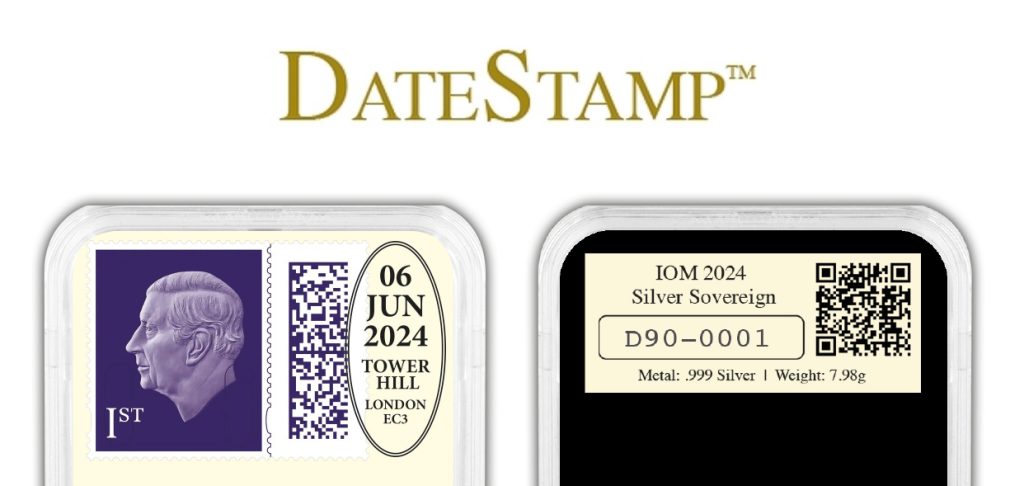
At The Westminster Collection, we take pride in offering collectors unique & exclusive pieces. The DateStamp™ series exemplifies this with a distinctive approach to commemorating iconic moments.
What makes DateStamp™ collectables truly special?
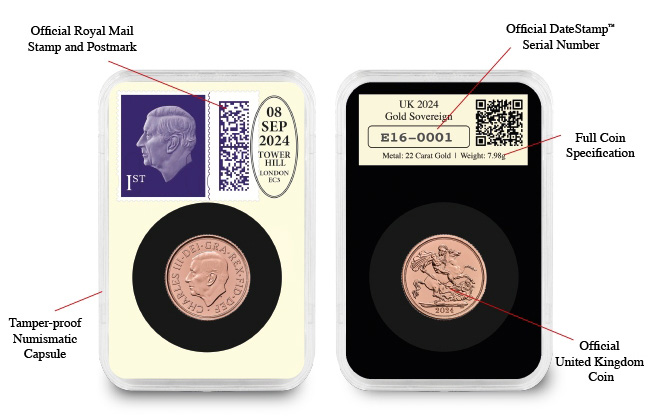
- Official Coin or Medal
Every DateStamp™ includes a fully authenticated coin or medal, ensuring you hold a legitimate and certified piece of numismatic heritage. - Moment in Time
A one-day-only postmark from Royal Mail makes each piece a time capsule, tying it to a significant event. This exclusive postmark is carefully selected to commemorate historical milestones, adding immense value and importance to your collectable. - Registered to You
Uniquely serialised and individually registered, each DateStamp™ coin or medal emphasises authenticity and its limited-edition status. The serial number not only guarantees your collectable’s origin but also highlights its exclusivity within the series, making it an extraordinary keepsake. - Protected Forever
Encased in tamper-proof capsules, DateStamp™ items are preserved in perfect condition. Favoured by collectors worldwide, these protective capsules ensure your coin or medal remains unblemished, retaining its value and beauty for generations to come.
Why Collect DateStamp™?
These collectables have become highly sought after for their historical significance, rarity, and impeccable quality. Owning a DateStamp™ means preserving a part of history, ready to be passed down as a treasured heirloom.
Discover our range of DateStamp™ coins and medals and secure your piece of history today. Visit The Westminster Collection DateStamp™ Range to explore these timeless treasures.
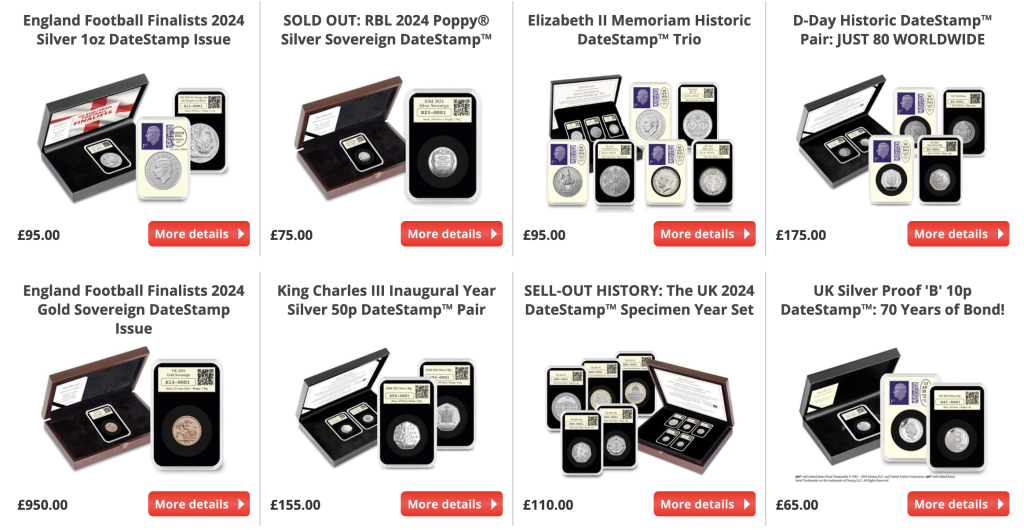
Artwork by Renowned Aviation artist Tim O’Brien recommissioned for NEW Limited Edition Concorde Set

When we think of aviation legends, few aircraft capture the imagination quite like Concorde. Sleek, supersonic, and effortlessly stylish, Concorde wasn’t just a mode of transport but a marvel of engineering that changed aviation forever. Now, a new opportunity has emerged for enthusiasts and collectors alike: the chance to own FIVE Supersonic Concorde Commemoratives featuring artwork by renowned aviation artist Tim O’Brien recommissioned for this Concorde set.
Tim O’Brien’s Artistic Mastery
Aviation art enthusiasts will already be familiar with Tim O’Brien’s name. His breathtaking work has been celebrated far and wide, capturing the spirit of flight in a way few artists can. O’Brien’s pieces don’t just depict aircraft; they convey the majesty of the skies and the meticulous detail of every rivet and curve. His original Concorde watercolour, once exhibited at the prestigious Guild of Aviation Artists Exhibition at the Mall Gallery in London, quickly became a sensation, with prints selling out and becoming highly prized collectibles.

The Mall Gallery itself is known for showcasing works that can command prices of £1,000 and beyond. Yet, here’s the incredible part: today, you can own five remarkable pieces inspired by O’Brien’s Concorde originals, all for just £29.99 (+p&p).
Five Skylines, Five Legendary Moments
This limited-edition set celebrates Concorde’s iconic journeys across some of the world’s most famous cities. Each commemorative features a scene that captures Concorde in all its supersonic glory:
- London, the city that helped launch Concorde into fame.
- Paris, a partner in Concorde’s innovation and home to its impressive engineering feats.
- New York, where passengers disembarked in half the usual transatlantic flight time.
- Sydney, symbolising Concorde’s range and ambition to connect the world’s most distant points.
- Washington, another destination that witnessed the era of supersonic luxury.
The detail and quality of these pieces are nothing short of mesmerising, with each commemorative bringing to life Concorde’s beauty against stunning cityscapes.
A Legacy That Endures
Why does Concorde still captivate us? Perhaps it’s because Concorde was a technological marvel that operated ahead of its time, cruising at Mach 2.04 (more than twice the speed of sound). With a top speed of over 1,350 mph, Concorde was faster than a bullet and could fly from London to New York in under 3.5 hours. In an era before widespread internet connectivity, Concorde made global travel feel truly instantaneous.

Concorde’s first commercial flight took place on January 21, 1976, and the aircraft continued to serve for 27 years until its final flight in 2003. During that time, Concorde carried royalty, celebrities, and business leaders in an unparalleled fusion of speed and luxury. It remains the only supersonic passenger aircraft ever to have seen regular service, a feat unmatched to this day.
Affordable Fine Art for Collectors
These commemoratives aren’t just a tribute to a bygone era of supersonic luxury; they are an affordable way to own a piece of fine art history. Tim O’Brien’s work, which has been revered and collected around the world, is now within reach for aviation enthusiasts and art lovers alike. For just £29.99 (+p&p), you can secure a limited-edition set that pays homage to Concorde’s breathtaking legacy and captures the essence of O’Brien’s masterful artistry.
Secure your set today for just £29.99 (+p&p) and celebrate Concorde’s unforgettable mark on the world.


